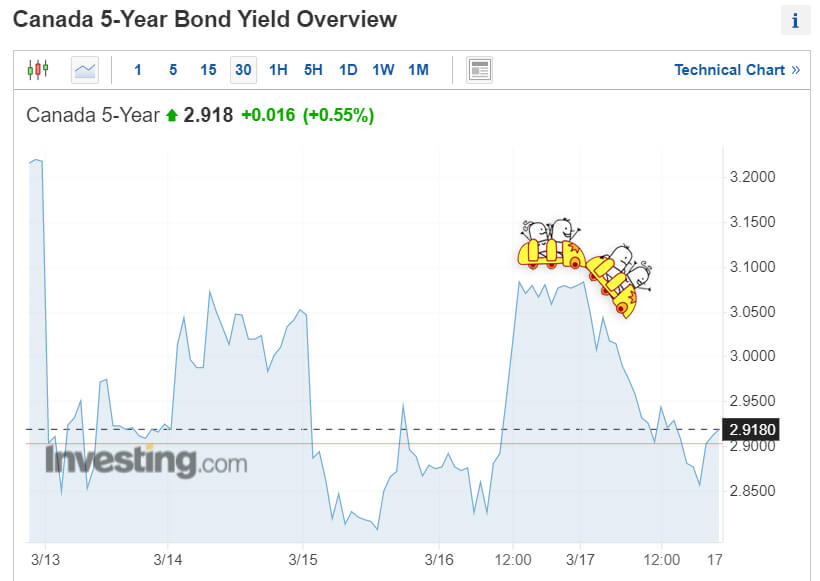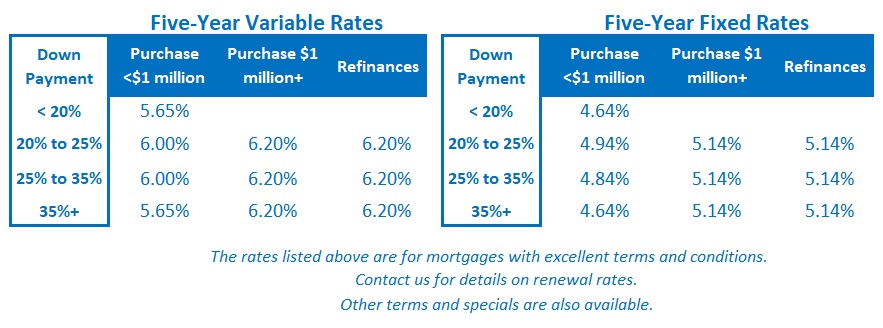Five Key Updates for Canadian Mortgage Rates
March 13, 2023More Near-Term Rate Hikes Are off the Table (But So Are Rate Cuts)
March 27, 2023The inflation debate has suddenly taken a backseat to concerns about systemic financial risk in both the US and Europe.
Within a short period of time the failure of Silicon Valley Bank (SVB) was followed by the collapse of Signature Bank, the provision of emergency lifelines to First Republic Bank, and then the fire sale of Credit Suisse to UBS.
Events like these shouldn’t be entirely surprising. They are examples of the concomitant ‘pain’ that our central bankers warned would be a necessary by-product of their rapid series of rate hikes. As Warren Buffet might put it, after more than a decade of practically free money, the tide is now going out and we’re finding out who has been swimming naked.
Growing concerns about the global financial system’s ability to withstand a series of shocks, and the tendency of financial markets in such circumstances to assume the worst until convinced otherwise, have caused a surge in the demand for safe-haven assets, such as government bonds. Investors are now more concerned about the return of their capital than they are about the return on their capital.
Thus far, however, while Government of Canada (GoC) bond yields have plummeted, the fixed mortgage rates that are priced on them either haven’t changed at all or have decreased by only a fraction of the corresponding drop in GoC bond yields. To wit, the five-year GoC bond yield has fallen by 0.69% since news of the SVB failure broke, but default-insured five-year fixed mortgage rates are down only 0.15% over the same period and many lenders haven’t moved their uninsured five-year fixed rates at all.
That has led many of the borrowers I am currently working with to ask: “Dude, where’s my rate drop?”
There are several reasons why it hasn’t materialized yet.
For starters, lenders become understandably cautious during periods of intense volatility – and last week’s five-year GoC bond yield movements certainly meet that definition (see chart). Lenders, and the institutional investors who fund their mortgages, won’t be in a hurry to put more of their capital at risk until they are confident that the recent bank failures aren’t precursors to a broader market meltdown.
Lenders, and the institutional investors who fund their mortgages, won’t be in a hurry to put more of their capital at risk until they are confident that the recent bank failures aren’t precursors to a broader market meltdown.
Also, while a lender’s base borrowing rates are falling, when they plunge in response to financial stability concerns there is always an accompanying increase in the risk premiums that lenders must pay.
We saw an example of this during the oil-price crash of 2015. Back then, the Bank of Canada (BoC) responded by making two 0.25% cuts to its policy rate. But lenders only dropped their prime rates, which our variable-rate mortgages are priced on, by 0.15%. Lenders held back the remaining 0.10% of each rate cut to preserve their profit margins, which were being squeezed by spiking risk premiums.
Additional mortgage rate drops may be forthcoming if the financial markets stabilize, and bond yields remain at their current levels but that will depend on how things play out over the near term. The range of possible outcomes is still wide.
If more bank failures materialize and financial markets continue to experience a crisis of confidence, all bets are off. But regulators and healthier banks have responded quickly, and if the damage is contained, it is also possible that this whole episode will be nothing more than a footnote in history books.
Here is a current summary of how the bond market thinks these market tremors will impact rates and our economies over the short term:
- Investors now expect the US Federal Reserve to raise its policy rate by 0.25% when it meets this week, instead of the 0.50% hike that was priced in before SVB’s collapse.
- The consensus expects that concerns over financial-market stability will reduce the general availability of credit and hasten the arrival of the recession that had already been priced in.
- The bond market now also expects that this will be the Fed’s last hike, a big change from the previous expectation of another 1.00% in raises this year. It is instead now pricing in three or four 0.25% cuts by the Fed before the year is out, with the first one starting as early as June.
- In Canada, the bond-futures market now expects that the BoC will cut its policy rate by 0.25% at its meeting on June 7 and is alternating between expectations of total cuts of 0.50% and 0.75% by year end.
When considering the shifts in market expectations outlined above it is important to note that futures pricing is notoriously volatile.
There is also a scenario where fixed rates fall to an extent that they buoy demand and stoke inflationary pressures. If that happens, the Fed and the BoC may be compelled to hold their policy rates steady to counteract that stimulative impact. In this zero-sum scenario, fixed-rate mortgage borrowers would win at the expense of variable-rate borrowers.
If you’re in the market for a mortgage today, I continue to believe that three-year fixed rates are the safest middle-of-the-road pick. They don’t come with the significant premiums that you have to pay for one- or two-year fixed rates. Also, three years should be enough time for higher rates to cool inflation if it ends up being stickier than the bond market currently expects (and as our central bankers have warned).
Variable-mortgage rates will look more appealing if the BoC ends up cutting its rates in response to the current financial-market turmoil. But it would take a 1% cut to bring today’s five-year variable rates in line with their five-year fixed rates equivalents. There is no guarantee that additional cuts will materialize thereafter. (For reference, in 2015, after the BoC cut by 0.50% in response to the oil price crash, its next move was to hike rates by 1.25% starting in July of 2017.)
 The Bottom Line: GoC bond yields have fallen off a cliff. For the reasons outlined above, cuts to fixed mortgage rates have been slower to materialize.
The Bottom Line: GoC bond yields have fallen off a cliff. For the reasons outlined above, cuts to fixed mortgage rates have been slower to materialize.
Over the short-term, more bad news relating to bank runs and resulting weakness in the financial system could continue to push bond yields lower. If they remain at those levels, fixed mortgage rates will eventually drop but only after the dust settles and the extent of the damage to public confidence in the global banking system becomes clear.
Variable-rate borrowers may see rate cuts sooner than previously expected if the current bond-futures market expectations prove correct. But I would caution anyone against pinning too much hope to that notoriously volatile part of the bond market.
We shouldn’t forget that inflation is still too high on both sides of the 49th parallel. The Fed and the BoC are still telling anyone willing to listen that tighter monetary policy will likely be needed for some time yet.








